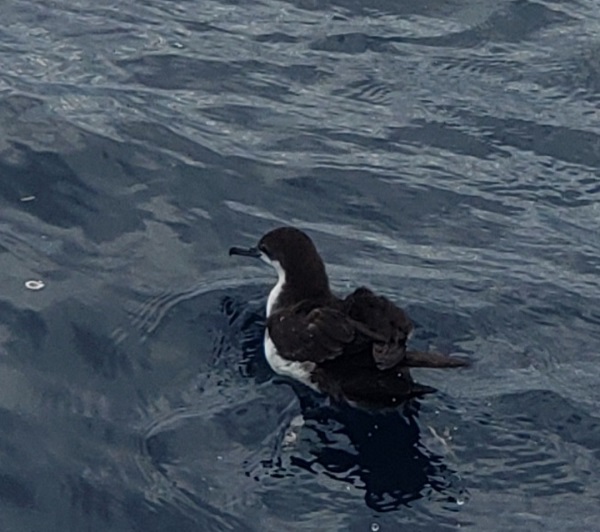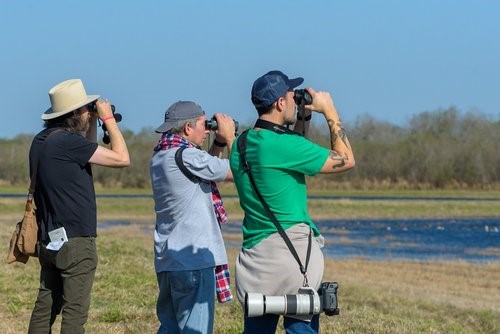Dan Brooks, Ph.D.
HMNS Curator of Vertebrate Zoology
The Frensley/Graham Hall of African Wildlife, built 2002-04 was a new variation of a common traditional theme at HMNS, in that we wanted to portray more than just the Serengeti ecosystem. Prior versions of the hall focused on the Serengeti, which while a very important ecosystem, was a mere fraction of the continent. In late Fall of 2003, Phase I debuted, featuring dioramas representing the Congo Basin, West African Forest, Ethiopian Scrub and Serengeti Savannah. In late Spring of 2004, Phase II debuted, featuring dioramas representing Okavango Delta, South African Lowveldt, Saharan Desert, and a rotating case.
The new exhibit was a smash hit, not only for portraying various ecosystems within the continent, but also for providing various themes in Wildlife Ecology and Conservation. The result was, what the visitor could see is the whole ecosystem, with elements of time and space removed, so that the species and landscapes are all brought to full view simultaneously in one ‘snapshot’.
As exciting as the new hall was, some updates were in order since the opening was already well over a decade. In total, we added 23 new specimens representing 13 new species not currently on display, along with adding a couple of other species that are already on display. This brought the total number of specimens on display in the hall to over 125, representing around 90 species.
West African Wetland
Perhaps, the most exciting addition is the West African Wetland diorama featuring an African Elephant (Loxodonta africana). Elephants have the distinction of being the largest living land animal on the planet. There are actually two species in Africa, those from the Savannah (Loxodonta africana) that you see in this diorama, and a smaller species that lives in forest, aptly called the Forest Elephant (L. cyclotis). Additionally Asia harbors several subspecies of Asian Elephant (Elephas maximus), including the Pygmy Elephant endemic to Borneo. These living species are the last of a lineage of much more hairy relatives that walked the planet during the Pleistocene, known as Mammoths (Mammuthus primigenius) and Mastodons (Mammut americanum).
Elephants are vital landscape architects in the tropical regions they inhabit. They are important for seed dispersal, carrying seeds to spawn and grow away from the parent plant. Moreover, they are important at molding landscapes, removing plants that would otherwise monopolize a habitat, providing a variety of refugia for smaller animals by toppling trees onto their sides, and other important roles. Indeed, in areas where elephant populations have exceeded the number that can be comfortably supported at a given site, the landscape becomes quite denuded.
Unfortunately elephants are tied for the one thing that is as coveted by some cultures as gold or diamonds – ivory. The demand for the illegal trade in ivory has pushed elephants to the brink of extinction in many areas. In some regions of Africa, tuskless elephants have been evolutionarily favored over their tusked brethren. If elephants don’t have tusks they are of little value to poachers and thus not hunted, which means tuskless genes are carried forth to future generations.
Several species of aquatic and semi-aquatic bird species round out the West African Wetland diorama, including small flocks of Cattle Egrets (Bubulcus ibis) and White-faced Whistling Ducks (Dendrocygna viduata), as well as Black Crowned Crane (Balearica pavonina) and African Open-billed Stork (Anastomus lamelligerus).
If the Cattle Egret looks familiar to you, it is perfectly understandable. They are commonly seen in Texas pastures, usually near the cattle that the bird follows in order to snatch up the insects that they panic into movement. But the Cattle Egret perfected this foraging technique on the African plain, following antelope and other large grazers. It arrived in the New World via storm systems that carried the bird across the Atlantic, from the west coast of Africa to northeastern Brazil, whereupon the birds gradually dispersed to the south, west and north.
While similar in appearance to a duck, White-faced Whistling Ducks are actually closer related to swans, which they share a long neck in common with. Several species of whistling ducks are distributed throughout the globe, occupying every continent except for Antarctica. They get the name whistling duck from their call, but are also known as tree ducks do to their habit of perching and nesting in trees. The closely related Black-bellied Whistling Duck is ubiquitous around Houston. Like Cattle Egrets, White-faced Whistling Ducks dispersed across the Atlantic on their own, thus populating both Africa and Latin America.
Found in the tropical belt of Africa, Black Crowned Cranes are rare and classified as Vulnerable due to habitat loss and trapping for food and commerce. They are typically associated in bonded pairs that mate for life, occupying grasslands and wetlands such as depicted in the diorama. Cranes are well known for their loud duet calls, with contributions by both male and female simultaneously. In contrast to most cranes (genus Grus), crowned cranes give loud honking noises, similar to a clown’s horn on a circus car! For the different voice and other reasons, crowned cranes are placed in their own genus, including both this species and the Blue Crowned Crane (B. regulorum) from East and Southern Africa.
The African Open-billed Stork gets its name from the space between the mandibles of its bill. This modification of the bill aids in handling molluscs to consume; freshwater snails are their preferred food. Although they may be in flocks up to 7000 individuals, they prefer to feed alone. Like many species, their breeding season is in the spring when resources are abundant. African Open-billed Storks perform complex displays, involving head-bobbing, bill-clattering, and rocking back-and-forth with the head held between the legs.
African House Bat/Evolution Kiosk
To the right of the new West African Wetland diorama is a new kiosk featuring a label about ‘speciation and describing new species’, using as the model, new species of African House Bats (Scotophilus) I described in 2014 with my colleague John Bickham. Featured are one of the four new species, Andrew Rebori’s House Bat (S. andrewreborii) along with the species it was split from, African Yellow House Bat (S. dinganii).
New species evolve via a number of different modes, the most common of which involves isolation. Oceanic islands are perhaps the first and most extreme form of isolation, but such ‘islands’ can also form on mainlands – imagine a mountaintop where the species inhabiting the very top is unable to exist at lower elevations – that’s an island barrier. Other examples include species cratered in valleys between mountains or rivers, or other barriers created by contrasting habitats. Over evolutionary millennia, those species with a common ancestor undergo separate trajectories with their own unique set of adaptations, such that ultimately they are very different. Distinguishing and describing these new forms is the job of a museum zoologist.
On occasion one stumbles upon a new species while examining museum specimens and noticing something distinct, or running DNA analyses and also noticing something distinct. These tandem situations led to the description of four new species of African House Bats: Livingstone’s (Scotophilus livingstonii) of tropical central Africa, Andrew Rebori’s (S. andrewreborii) and Trujillo’s (S. trujilloi) of Kenya, and Ejetai’s (S. ejetai) from Ethiopia. Firming this up with morphological and DNA analyses led to the description of these four new species.
Ethiopian Scrub
Several birds were added to the Ethiopian Scrub diorama, including a pair of Yellow-necked Spurfowl (Francolinus leucoscepus) which are endemic to this ecosystem, and have bright yellow bare patches on their throats, as the name implies. Other endemics were added, such as individuals of Vulturine Guinea Fowl (Acryllium vulturinum) and Superb Starling (Lamprotornis superbus), to help build social groups of current individuals already represented in the diorama.
Yellow-necked Spurfowl are actually a species of Francolin, which are gamebirds found throughout Africa. Spurfowl tend to associate in pairs (a male and female) as depicted in the exhibit. Like other gamebirds they will use their powerful claws as a digging tool to expose grubs, roots, tubers, and other delicacies they enjoy eating. They have a very powerful voice that can be heard at quite a distance. Genders are identical, although the male is a bit larger.
Except when breeding, Vulturine Guinea Fowl occur in medium to large flocks that spend the day scratching on the ground looking for food. They are, however, strong fliers and roost in trees overnight. Although they will take water when it is available, they can exist for long periods without drinking. In spite of its name, the Vulturine Guineafowl is not a carrion eater, but rather an omnivore who will take a variety of invertebrates, seeds, and fruit. Its featherless head gives it a superficial resemblance to vultures, which accounts for its common name.
The spectacularly colored Superb Starling is a common East African bird. It feeds mainly on the ground, eating a range of seeds, fruits and insects. It will devour food scraps and small flocks will often gather where people offer it food, making it popular with tourists. While this species will nest in cavities like most starlings, it often builds large domed nest in low thorn bushes. Sometimes a breeding pair is assisted by non-breeding offspring from earlier broods.
Saharan Desert
The Saharan Desert diorama was always a bit barren, lacking more examples of migratory birds and carnivores, so it was exciting to be able add both. Mammalian carnivores include Pale Fox (Vulpes pallida) and Caracal (Felis caracal), the latter of which is carrying off a hyrax from the small familial group on the cliff. Additional migrants include a flock of the European Wood Pigeon (Columba palumbus), as well as an example of the exquisite Demoiselle Crane (Grus virgo) standing next to the date tree.
The Pale Fox lives in the latitudinal band across the southern Sahara of Africa known as the Sahel Strip. A species of the desert, the Pale Fox is more active at night to opportune cooler temperatures. During the daytime they rest in the cool environment of underground burrows that can reach nearly 50 feet in length, while several feet underground. The large ears are adaptations for enhanced hearing, and the sand-colored pelage helps them blend into their environment. Another adaptation for desert life is the ability to obtain all needed water from their food, they drink little water (if any).
The Caracal is also known as the African Lynx, owing to the tufts of hair tipping the ears which it shares in common with the true Lynx (Lynx canadensis). It can live from sea level to 10,000 feet in a variety of habitats – not only in Africa, but also northeast through the Middle East to western India. While it may take a variety of game, the majority of its diet is comprised of mammals ranging in size from rodents to large antelope. The speed and agility of the Caracal permit it to take mammals up to three times its size. Caracals were apparently important symbols to ancient Egyptians. Sculptured Caracals guarded tombs of Pharoahs, and ancient paintings and bronze figurines have been discovered as well.
The smallest of the world’s 15 species of cranes, the Demoiselle Crane was given its name by Marie Antoinette. Demoiselle means young lady or maiden in French, the queen was enchanted by the crane’s demure and maidenly appearance. The geographic range covers a wide latitudinal band across Asia, with the Mongolian/Chinese population migrating to India for the winter, and the population between the Caspain and Black Sea, including Turkey, migrating south to spend winter in the Saharan Desert.
The largest of the grain-eating pigeons, the European Wood Pigeon can be found in a variety of habitats from city parks to woodland. This species is one of the most commonly seen birds in Europe, ranging southwest to the Saharan Desert, as far east as parts of Mongolia and China and south to India. Like most pigeons they have a clutch of two white eggs laid atop a flimsy platform of twigs; the squabs fledge at approximately three weeks of age.
Ethiopian Highlands
Last but by no means least, is the Ethiopian Highland microcosm to replace the Bontebok (Damaliscus pygargus) in the rotating case. Like many animals living in Ethiopia, the Gelada Baboon (Theropithecus gelada) and Erckel’s Francolin (Francolinus erckelii) are endemics that occur in no other country on the planet except for Ethiopia. In fact, both of these species are among several that are restricted to the Highlands of Ethiopia rather than the Lowlands depicted in the circular diorama.
The Gelada is so unique, it is in a monotypic genus, meaning that it is the sole member of the genus Theropithecus and has no closely related living relatives. Many characteristic make the Gelada totally unique from other species of baboons (genus Papio). Large troops of Geladas spend the night perched below a cliff ledge on rocky cliff face for protection from predators. Not only is their nighttime cliff face bunking behavior unique among monkeys, but they are the only species of primate that subsists entirely on grass blades and grains. After scaling back up the cliff face in the morning, they spend the day foraging in grassland above the cliff.
Francolins are gamebirds that fill the ecological equivalent of pheasants and partridge in Asia, or grouse and quail in North America. Overall they are closest related to partridge. Approximately 25 species of francolins are found throughout Africa, with an additional five species hailing from Asia. They vary extensively in size and color. Like other gamebirds they will use their powerful claws as a digging tool to expose grubs, roots, tubers, and other delicacies they enjoy eating. They have a very powerful voice that can be heard at quite a distance. Males and females are identical, although the male is a bit larger.










